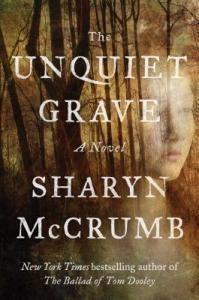
Book Cover Image: The Unquiet Grave by Sharyn McCrumb
" data-orig-size="265,400" sizes="(max-width: 199px) 100vw, 199px" aperture="aperture" />BOTTOM LINE: Meh. I don’t regret reading it, but I could have read something much better had I skipped it.
Genre: Historical Fiction
Publication Date: 12 September 2017
Source: Publisher via NetGalley
“Lakin, West Virginia, 1930
Following a suicide attempt and consigned to a segregated insane asylum, attorney James P. D. Gardner finds himself under the care of Dr. James Boozer. Fresh out of medical school, Dr. Boozer is eager to try the new talking cure for insanity, and encourages his elderly patient to reminisce about his experiences as the first black attorney to practice law in nineteenth-century West Virginia. Gardner’s most memorable case was the one in which he helped to defend a white man on trial for the murder of his young bride—a case that the prosecution based on the testimony of a ghost.
Greenbrier, West Virginia, 1897
Beautiful, willful Zona Heaster has always lived in the mountains of West Virginia. Despite her mother’s misgivings, Zona marries Erasmus Trout Shue, the handsome blacksmith who has recently come to Greenbrier County. After weeks of silence from the newlyweds, riders come to the Heasters’ place to tell them that Zona has died from a fall, attributed to a recent illness. Mary Jane is determined to get justice for her daughter. A month after the funeral, she informs the county prosecutor that Zona’s ghost appeared to her, saying that she had been murdered. An autopsy, ordered by the reluctant prosecutor, confirms her claim.
The Greenbrier Ghost is renowned in American folklore, but Sharyn McCrumb is the first author to look beneath the legend to unearth the facts. Using a century of genealogical material and other historical documents, McCrumb reveals new information about the story and brings to life the personalities in the trial: the prosecutor, a former Confederate cavalryman; the defense attorney, a pro-Union bridgeburner, who nevertheless had owned slaves; and the mother of the murdered woman, who doggedly sticks to her ghost story—all seen through the eyes of a young black lawyer on the cusp of a new century, with his own tragedies yet to come.”
My Thoughts: The Unquiet Grave is an interesting story with no real lasting power. I suspect it means more to those who are familiar with the folklore prior to reading the novel. Even without any prior knowledge, very little of the story is an actual surprise. Ms. McCrumb is very heavy-handed in her foreshadowing, and the modern-day obsession with true crime stories makes it all too easy to see where Zona’s story is heading.
From a historical perspective, Ms. McCrumb gives readers a decent insight into the lasting tension that existed even forty years after the Civil War. She raises awareness that this was more than racial tension, although that did obviously exist. Things like someone’s war record, in which campaigns they fought, for which side, all played a role in establishing someone’s position in society. Set in the foothills of West Virginia, it is a side of the turn-of-the-century America most readers do not get to see.
She also paints a realistic picture of the hardships farmers in Appalachia faced. These are not the coal farmers one typically thinks of when envisioning West Virginia. These are the types of farmers who founded our country – small, family-owned, barely able to survive in the lean times, for whom frivolous things like a separate dress for a wedding is as unthinkable as it is unpractical. Understanding Zona’s background makes it easier to understand why she married a man she barely knew as well as the reasons her mother did not discover her fate until it was too late.
Had the story stayed focused solely on Mary Jane, the flow would be smoother and more engaging. Unfortunately, the story splits its time between Mary Jane’s search for justice and that of one of the lawyers assigned to the case. Except Gardner’s story takes place forty years after the fact, so the context is wrong. Plus, we find out that he was not the head lawyer for the case. He was nothing but the associate lawyer assigned to do most of the research. His role in the novel is misleading and disappointing and more than a little confusing. Some of this is because of his lack of role in the proceedings. The rest is due to the shift not only in narrator but also in point of view. With Mary Jane, we get a first person perspective, allowed access inside her mind as she processes her life and her actions. With Gardner, it is a third-person limited point of view. We only learn his story as he tells it to his doctor. It is too distant in time and perspective to blend well with Mary Jane’s sections of the novel, and they did nothing to improve my understanding or enjoyment of the story. I often found myself skimming if not skipping entire passages of Dr. Gardner’s scenes in order to get past them as quickly as possible.
Much like the mode of travel Mary Jane must use to travel to see her daughter, The Unquiet Grave is a relatively slow, plodding novel. The details about Mary Jane’s life and her search for clues is interesting and one of the saving graces of the story. The rest is a meandering slog through racial, socio-economic, and generational tensions that attempt to establish the setting but do more to distract and disengage. The scenes involving Gardner are disappointing and relatively meaningless in the overall context of the story. Those potential readers who already know the story of The Greenbriar Ghost may have a greater appreciation for The Unquiet Grave and Ms. McCrumb’s research into the details behind the legend. As it is, I found it a tedious read with only occasional sections of historical interest.
